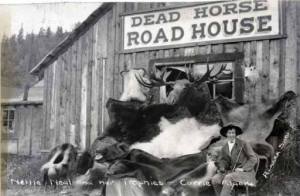 In his 2003 book Lavish Silence (Trapper Creek Museum/Sluice Box Productions), about the now-vanished railroad community of Curry, author Kenneth L. Marsh explained that the name of this roadhouse was based on a railroad construction camp beside the Susitna River at mile 248 of the Alaska Railroad: “This, of course, meant it was 248 miles north of Seward, the starting point of the railroad. It also put this camp 22 miles north of the recently reserved townsite of Talkeetna and approximately halfway to Fairbanks. Deadhorse Hill was the name first given the remote camp. It is said that the name was given early on in 1916 when a team of horses fell to their death from the top of a nearby steep hill after being frightened upon seeing a bear.”
In his 2003 book Lavish Silence (Trapper Creek Museum/Sluice Box Productions), about the now-vanished railroad community of Curry, author Kenneth L. Marsh explained that the name of this roadhouse was based on a railroad construction camp beside the Susitna River at mile 248 of the Alaska Railroad: “This, of course, meant it was 248 miles north of Seward, the starting point of the railroad. It also put this camp 22 miles north of the recently reserved townsite of Talkeetna and approximately halfway to Fairbanks. Deadhorse Hill was the name first given the remote camp. It is said that the name was given early on in 1916 when a team of horses fell to their death from the top of a nearby steep hill after being frightened upon seeing a bear.”
![Officials in front of the Talkeetna District Headquarters at Deadhorse Hill, August, 1918 [AEC Collection]](https://alaskanroadhouses.wordpress.com/wp-content/uploads/2015/06/screen-shot-2015-06-12-at-10-37-40-am.png?w=300&h=235)
Officials in front of the Talkeetna District Headquarters at Deadhorse Hill, August, 1918 [AEC Collection]
“Deadhorse Hill Camp … will be the headquarters for the construction forces during the early spring and summer operations. This is one of the old camps remaining from the early period of construction operations, and it is well laid out and well built from cottonwood lumber sawed at the site.”
![Mears Memorial Bridge, completed in 1923, crossing the Tanana River at Nenana [LoC photo taken shortly after completion in 1923]](https://alaskanroadhouses.wordpress.com/wp-content/uploads/2015/06/screen-shot-2015-06-12-at-11-04-13-am.png?w=300&h=212)
Mears Memorial Bridge over the Tanana River at Nenana [LoC photo taken shortly after completion in 1923]
Because Deadhorse Hill was such a key location, a large roadhouse was built at the site in 1917 to accommodate the construction workers, officials, and occasional visitors. Management of the new roadhouse was given to a woman who was already a much-loved figure on the Alaska Railroad, an intrepid big game hunter and sled dog musher who, for three years, had held the contract for the Grandview Roadhouse at mile 45, at the southern end of the tracks near Seward. Nellie Neal’s gift for storytelling and entertaining her guests, along with her notable skill with a rifle (which assured plenty of meat on the tables), and her selfless bravery in rescuing a lost mail driver with her dog team had elevated her to near-legendary status along the railroad.
Wiry and independent, Nellie took on running the Deadhorse Roadhouse with all the pluck and dedication she’d shown at Grandview, cooking meals on two large ranges for the dining room which seated 125 hungry workers at a time, and filling 60 lunch-buckets each night for the construction crews to take on their jobs the following day. In Lavish Silence Kenneth Marsh described the roadhouse accommodations: “…spring-less wooden bunks, straw mattresses and oil-drum wood-burning stove, all in one large room at the top of a flight of rickety stairs, held together by a warped wooden shell (which, at times, put up an uneven fight against the elements).”
In July, 1923, President Harding, his wife, and Secretary of State Herbert Hoover stayed at the Deadhorse Roadhouse on their way to the Golden Spike-driving ceremony at Nenana. The next morning Nellie served heaping plates of sourdough pancakes in her warm kitchen, commenting, “Presidents of the United States like to be comfortable when they eat, just like anyone else!”
With the completion of the railroad came significant changes to the little community, largely in the form of a luxury resort hotel built across the tracks from the roadhouse by the Alaskan Engineering Commission. In 1922 the name of the community was changed to Curry, to honor Congressman Charles F. Curry of California, chairman of the Committee on Territories, who was a strong supporter of the Alaska Railroad.
Kenneth Marsh included an article from the December 2, 1922 issue of The Pathfinder of Alaska, newsletter of the Pioneers of Alaska, which described the impending demise of the Deadhorse Roadhouse: “The famous old roadhouse located at Mile 248 on the Government Railroad is now singing its Swan Song and will soon cease to function as a hostelry. The camp’s name has also been changed to Curry–named in honor of Senator Curry, Alaska’s friend.“The Alaskan Engineering Commission now has a large railroad hotel nearing completion, which will be modern in every detail. Electricity, steam heat, hot and cold water systems are being installed, telephones, baths, laundry, big dining room and other conveniences all under the same roof as the depot, will ensure comfort to all guests.
“Old timers, however, will always think of the place as Deadhorse and in the same flash of memory will recall the days when Nellie Neal, the proprietor and domineering spirit of the place, reigned supreme.”



!["At Curry, Alaska, 6/23/'22." [Angier family papers, UAF-1969-89-117]](https://alaskanroadhouses.wordpress.com/wp-content/uploads/2015/06/screen-shot-2015-06-12-at-3-22-56-pm.png?w=300&h=222)
